Re: Brake staff /cylinder confusion and mismatched trucks!!
Posted by Jim Courtney on Sep 15, 2015; 9:45pm
URL: http://c-sng-discussion-forum.254.s1.nabble.com/Brake-staff-cylinder-confusion-and-mismatched-trucks-tp3464p3468.html
Some more photos to further illustrate my confusion:
This photo of C&S 1049 is from Grandt's Narrow Gauge Pictorial VIII:, poorly reproduced here:
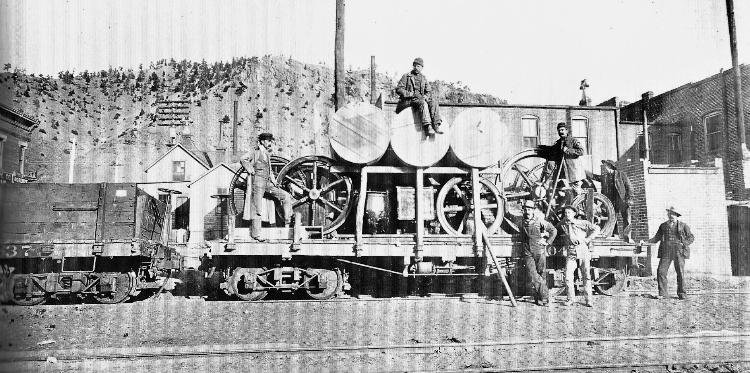
The car is listed in the roster as part of C&S series 1000-1054, 26 foot, 12 ton cars, in other words another Litchfield car. But more has happened than just re-lettering. The car was heavily shopped, either during the 1890s during the Trumbull receivership, or just after the C&S incorporation. The original 10" tapered Litchfield side sills have been replaced with straight 8" side sills butting to the end beam. The original Litchfield eight stake pocket pattern has been retained. To beef up the new frame, four 6" queen posts have been added to each of the needle beams for four truss rods without turnbuckles. The original Litchfield plate bolsters have been retained, but with 2" spacers between the bolster and the sills (yellow arrow).
This is essentially a new car, from old parts, though the original 12 ton Litchfield ("type-A") trucks have been retained. Yet when the brake cylinder and hardware was reinstalled, it was mounted ass-backwards, the brake staff to the left, behind the brake cylinder which points to the right. This implies a certain standard of the day, before the St Charles cars began arriving in 1897-98. The 27 foot coal car to the left demonstrates the beefier 14 ton truck common to those cars.
I don't think this car to be a one-of-a-kind anomaly, because two similar cars show up in Doug's "Pipes on Flats" photo:
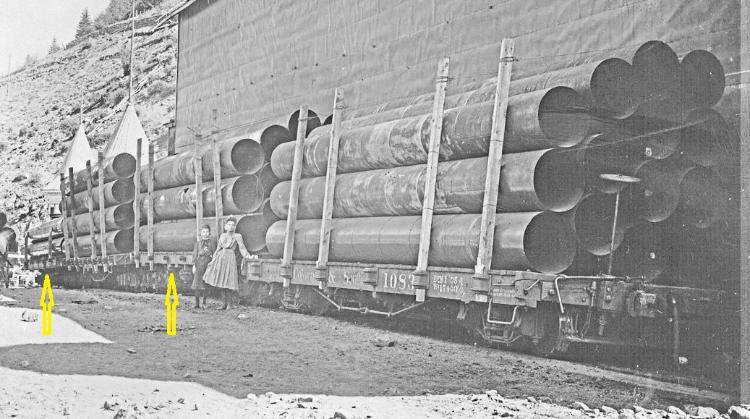
Another photo from c1901 at Kokomo shows a decent view of a Peninsular 30' coal car:
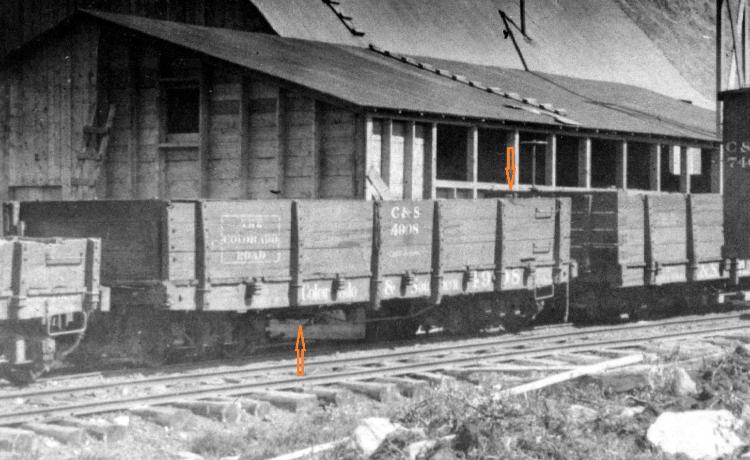
The brake cylinder is barely visible, likely on the far side of the car, but there is no brake staff on the near end of the car for it to be pointing to. A brake wheel may be present on the far end of the car, just visible in front of the St Charles coal car, but again behind the brake cylinder of number 4908.
Another photo from Grandt's Narrow Gauge Pictorial VIII:, also on the Park County website, listed under Alma Junction:
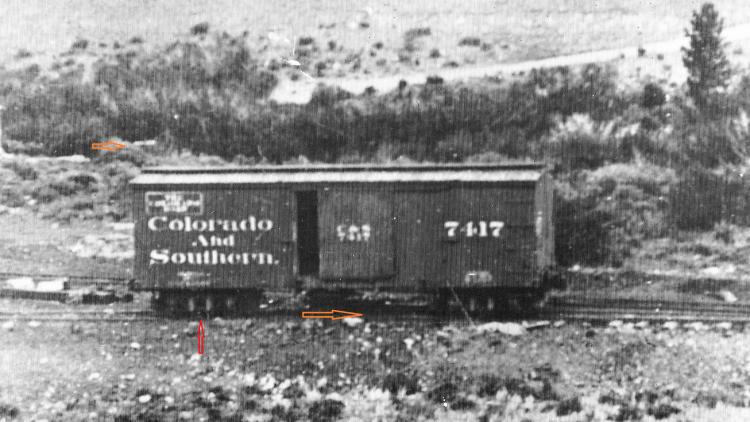
C&S number 7417 is another 27 foot, 14 ton UP built car of 1883. As there appears to be a knuckle coupler on the right end, I believe the photo dates to 1903-1904. Again the brake cylinder points to the right, though the brake staff is on the other end of the car (brake wheel just visible at orange arrow). The trucks also resemble the 14 ton coal car truck as above.
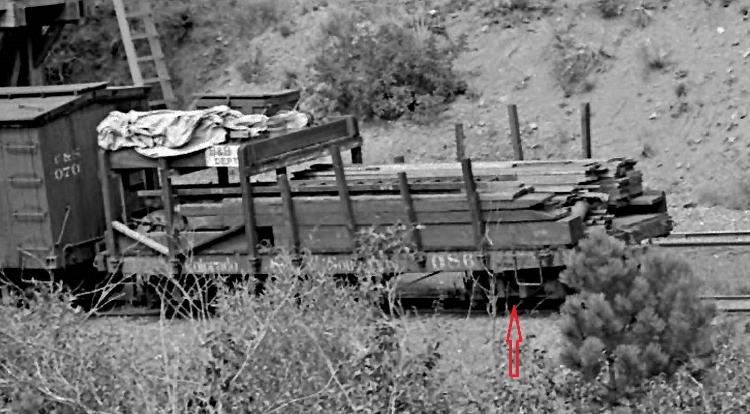
http://digital.denverlibrary.org/cdm/singleitem/collection/p15330coll22/id/78391/rec/787
B&B work flat 086 looks to be a standard Litchfield 26' flat car, but has 14 ton coal car type trucks, sometime after 1905.
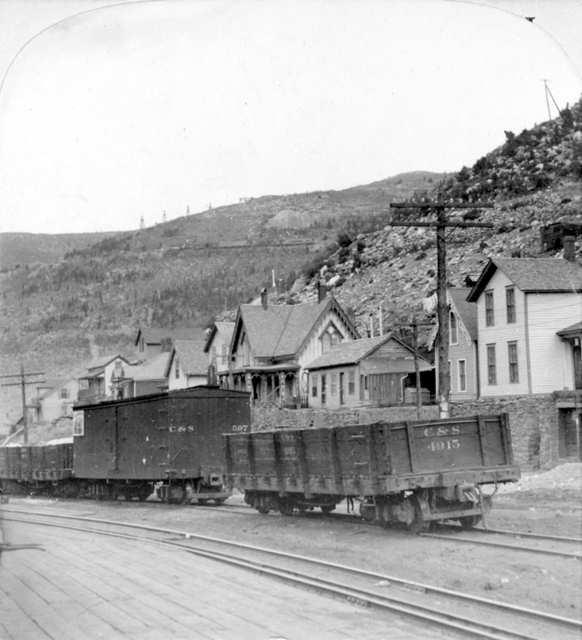
Finally, C&S 597, in Blackhawk, c1902, is a rebuilt 27 foot Tiffany reefer (horizontal lower edge of end fascia and absence of Tiffany vents). But the trucks appear to have taller transoms than those of the Peninsular coal car in the foreground, and again may be 14 ton trucks from the 27 foot coal cars.
I can understand the 14 ton coal car trucks showing up under all manner of freight cars. With the large number of new 30-foot St Charles coal cars being delivered to the UPD&G and to the new C&S, the 27-foot South Park coal cars of 1882-83 likely became obsolete. They rapidly disappear from the roster, while many of the 30-foot Peninsular coal cars stayed in revenue service for another 10-15 years, some even shopped and given the block monogram lettering scheme. So, there would have been lots of surplus 14 ton coal car trucks to recycle, upgrading older cars, especially those with 12 ton Litchfield trucks.
But this backward brake cylinder to brake staff arrangement still has me baffled--there are too many photos of cars with this arrangement to suggest that it was anything other than a standard practice. If anyone knows how the brake rigging actually looked, please let me know.
Jim
URL: http://c-sng-discussion-forum.254.s1.nabble.com/Brake-staff-cylinder-confusion-and-mismatched-trucks-tp3464p3468.html
Some more photos to further illustrate my confusion:
This photo of C&S 1049 is from Grandt's Narrow Gauge Pictorial VIII:, poorly reproduced here:

The car is listed in the roster as part of C&S series 1000-1054, 26 foot, 12 ton cars, in other words another Litchfield car. But more has happened than just re-lettering. The car was heavily shopped, either during the 1890s during the Trumbull receivership, or just after the C&S incorporation. The original 10" tapered Litchfield side sills have been replaced with straight 8" side sills butting to the end beam. The original Litchfield eight stake pocket pattern has been retained. To beef up the new frame, four 6" queen posts have been added to each of the needle beams for four truss rods without turnbuckles. The original Litchfield plate bolsters have been retained, but with 2" spacers between the bolster and the sills (yellow arrow).
This is essentially a new car, from old parts, though the original 12 ton Litchfield ("type-A") trucks have been retained. Yet when the brake cylinder and hardware was reinstalled, it was mounted ass-backwards, the brake staff to the left, behind the brake cylinder which points to the right. This implies a certain standard of the day, before the St Charles cars began arriving in 1897-98. The 27 foot coal car to the left demonstrates the beefier 14 ton truck common to those cars.
I don't think this car to be a one-of-a-kind anomaly, because two similar cars show up in Doug's "Pipes on Flats" photo:

Another photo from c1901 at Kokomo shows a decent view of a Peninsular 30' coal car:

The brake cylinder is barely visible, likely on the far side of the car, but there is no brake staff on the near end of the car for it to be pointing to. A brake wheel may be present on the far end of the car, just visible in front of the St Charles coal car, but again behind the brake cylinder of number 4908.
Another photo from Grandt's Narrow Gauge Pictorial VIII:, also on the Park County website, listed under Alma Junction:

C&S number 7417 is another 27 foot, 14 ton UP built car of 1883. As there appears to be a knuckle coupler on the right end, I believe the photo dates to 1903-1904. Again the brake cylinder points to the right, though the brake staff is on the other end of the car (brake wheel just visible at orange arrow). The trucks also resemble the 14 ton coal car truck as above.

http://digital.denverlibrary.org/cdm/singleitem/collection/p15330coll22/id/78391/rec/787
B&B work flat 086 looks to be a standard Litchfield 26' flat car, but has 14 ton coal car type trucks, sometime after 1905.

Finally, C&S 597, in Blackhawk, c1902, is a rebuilt 27 foot Tiffany reefer (horizontal lower edge of end fascia and absence of Tiffany vents). But the trucks appear to have taller transoms than those of the Peninsular coal car in the foreground, and again may be 14 ton trucks from the 27 foot coal cars.
I can understand the 14 ton coal car trucks showing up under all manner of freight cars. With the large number of new 30-foot St Charles coal cars being delivered to the UPD&G and to the new C&S, the 27-foot South Park coal cars of 1882-83 likely became obsolete. They rapidly disappear from the roster, while many of the 30-foot Peninsular coal cars stayed in revenue service for another 10-15 years, some even shopped and given the block monogram lettering scheme. So, there would have been lots of surplus 14 ton coal car trucks to recycle, upgrading older cars, especially those with 12 ton Litchfield trucks.
But this backward brake cylinder to brake staff arrangement still has me baffled--there are too many photos of cars with this arrangement to suggest that it was anything other than a standard practice. If anyone knows how the brake rigging actually looked, please let me know.
Jim
Jim Courtney
Poulsbo, WA
Poulsbo, WA
| Free forum by Nabble | Edit this page |